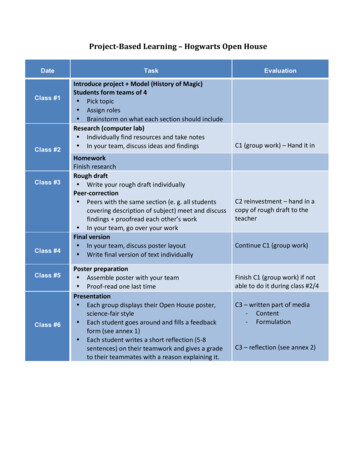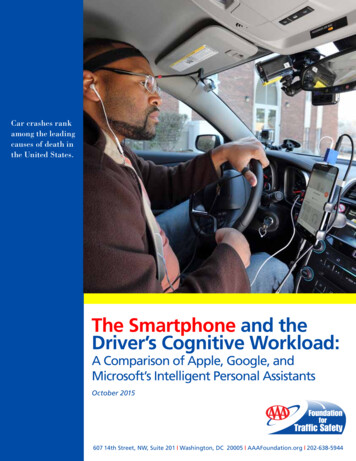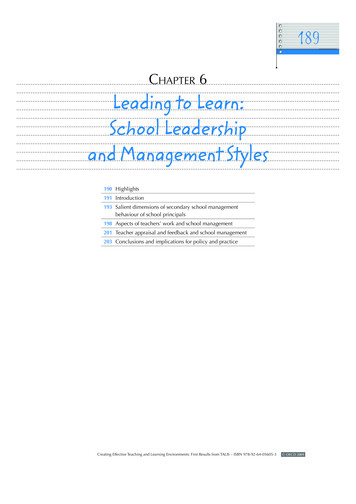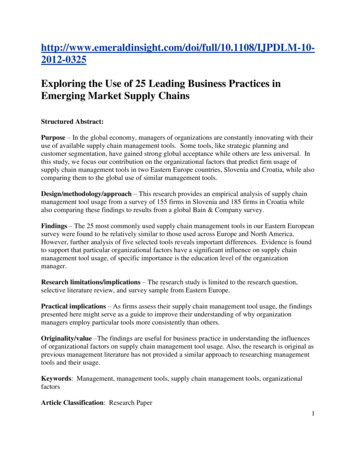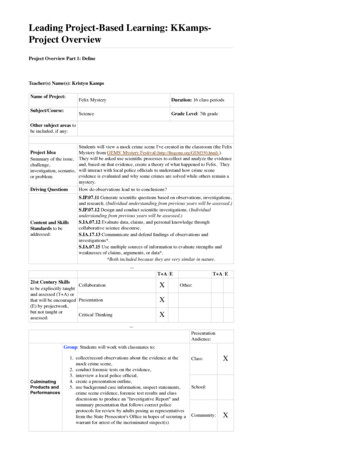
Transcription
Leading Project-Based Learning: KKampsProject OverviewProject Overview Part 1: DefineTeacher(s) Name(s): Kristyn KampsName of Project:Subject/Course:Felix MysteryDuration: 16 class periodsScienceGrade Level: 7th gradeOther subject areas tobe included, if any:Project IdeaSummary of the issue,challenge,investigation, scenario,or problem:Students will view a mock crime scene I've created in the classroom (the FelixMystery from GEMS' Mystery Festival (http://lhsgems.org/GEM350.html) ).They will be asked use scientific processes to collect and analyze the evidenceand, based on that evidence, create a theory of what happened to Felix. Theywill interact with local police officials to understand how crime sceneevidence is evaluated and why some crimes are solved while others remain amystery.Driving QuestionsHow do observations lead us to conclusions?Content and SkillsStandards to beaddressed:S.IP.07.11 Generate scientific questions based on observations, investigations,and research. (Individual understanding from previous years will be assessed.)S.IP.07.12 Design and conduct scientific investigations. (Individualunderstanding from previous years will be assessed.)S.IA.07.12 Evaluate data, claims, and personal knowledge throughcollaborative science discourse.S.IA.17.13 Communicate and defend findings of observations andinvestigations*.S.IA.07.15 Use multiple sources of information to evaluate strengths andweaknesses of claims, arguments, or data*.*Both included because they are very similar in nature.T A E21st Century SkillsCollaborationto be expliscitly taughtand assessed (T A) orthat will be encouraged Presentation(E) by projectwork,but not taught orCritical Thinkingassessed:XT A EOther:XX.PresentationAudience:Group: Students will work with classmates to:CulminatingProducts andPerformances1. collect/record observations about the evidence at themock crime scene,2. conduct forensic tests on the evidence,3. interview a local police official,4. create a presentation outline,5. use background case information, suspect statements,crime scene evidence, forensic test results and classdiscussions to produce an "Investigative Report" andsummary presentation that follows correct policeprotocols for review by adults posing as representativesfrom the State Prosecutor's Office in hopes of securing awarrant for arrest of the incriminated suspect(s)Class:XSchool:Community:X
Individual: Each student will be expected to:1. keep an individual reflection journal where they recordExperts:their best thinking regarding what happened to Felix,throughout and at the end of the experience,2. create a detailed "Crime Scene Map,"3. complete detailed observations of assigned pieces ofevidence and create a wiki page for each piece,4. present evidence information,5. fill out the individual "Evidence Chart" which will detail Web:which pieces of evidence implicate which characters inthe mystery,6. complete assigned homework which prepares them forthe next day's lesson,7. participate in class discussions, both in class and online, Other:8. use class time effectively.XPart 2: Design"Grabber" tolaunch inquiry &generate interest:Students will enter the classroom to find a crime scene that has been roped offusing police tape. They will be asked to observe what they see. The mock crimescene will include the outline of a body as well as other evidence. They will beread a short statement that gives context for what they uringProject)SummativeAssessments:(End ofProject)Moodle"quizzes" onhomework (passor ask questionsand eer nforumXReflection Journal (includestheories of what happened)XSuspect Chart (includes detail ofwhich pieces of evidence implicatewhich suspects)XEvidence Cards (each studentcompletes and posts 2)XRough drafts of presentationXIndividual theory on what happenedto Felix (should explain who isguilty and what evidence supportsposition in some detail; this is not amajor assignment, however)Group oral presentation of"Investigative Report Summary"with rubric(/f/Oral Presentation Felix.pdf)Investigative Report graded withrubricX(/f/Investigative Report Rubric.pdf)DebriefingMethodsReflection LogXSurveyXX(Individual,Group, and/orWhole Class) Whole class discussion.ResourcesNeededOn-site people, facilities:Computers (student laptops), cameras, USB cables,projectorEquipment:Crime scene set up, forensic test equipmentMaterials:GEMS Mystery Festival guide book, movie segmentsfrom United Streaming, The Science Spot: ForensicsLesson Plans, Forensic Science: Fundamentals andInvestigations by Anthony Bertino
Community resources:Official(s) from local police department; adults torepresent officials from the state's prosecutor's officeProject Teaching and Learning GuideProject: Felix MysteryCourse/Semester: 7th Grade Science/ 1st SemesterKnowledge and Skills Needed byStudentsto successfully completeculminating products andperformances, and do well onsummative assessmentsScaffolding/Materials/Lessons to be Providedby the project teacher, other teachers, experts, mentors,community members--Describe the active teaching needed tosupport learningForensics (http://player.discoveryeducation.comWhat constitutesevidence?How evidence is handledby law enforcementpersonnel/index.cfm?guidAssetId 173906D4-98A2-4091-8389-804E995C5A92&- blnFromSearch 1&productcode US) movie (United Streaming),"Physical Evidence (/f/physicalevidence.ppt) " power point,interview with police detective- Interview with police detective and movie I createWhat constitutes viablequalitative and- Review lesson on observationsquantitative observations?What type of reasoning isused to connect evidence - Class discussion; interview with police detectiveto suspects?What type of forensicMini lessons on fingerprinting, hair and fibers, chromatography,testing is done onpowders, pH, including mini labs (these will be 2 - 5 minuteevidence? How are these - movie clips I create; students will watch these as homeworktests run?before completing the mini practice labs in class)How can evidence be knittogether to create a logical - Class discussion, ongoing online discussion forum in Moodle,and interview with police detectivetheory?Project Calendar (Project should be 1 or more weeks)Project Start Date: Tuesday, September 8 (click here for detailed lesson plans)*Note: We begin school in August, so this experience does not begin on the first day of school.Week(s)MONDAYOneNo HURSDAYFRIDAYBackgroundinformationand SuspectStatementsInitial crimesceneinvestigationPreparing toTaking detailedobserve evidence observations ofin more detailevidencePracticingforensic testingForensic tests onevidenceForensic tests onForm theoryevidence; reviewpresentationtest results andgroupscategorizeProject work insmall groupsProjectPresentations togroups ofexpertsProject work in Project work insmall groupssmall groupsProjectPresentations&Debriefingsession*Allow at least one day for interview with police detective and/or other law enforcement experts
Rubric Made Using:RubiStar ( http://rubistar.4teachers.org )Oral Presentation Rubric : Investigative Report PresentationTeacher Name: Mrs. KampsStudent Name:CATEGORY4321ContentShows a fullunderstanding of thetopic. Implicatingevidencecommunicatedclearly andaccurately.Shows a goodunderstanding of thetopic. Implicatingevidence isgenerally clear andaccurate with a fewminor details.Shows a goodunderstanding ofparts of the topic.Implicating evidenceis generally faulty orpoorlycommunicated.Does not seem tounderstand the topicvery well.Presentation lacksconnections toevidence orevidence ismisrepresented.Speaks ClearlySpeaks clearly anddistinctly all(100-95%) the time,and mispronouncesno words.Speaks clearly anddistinctly all(100-95%) the time,but mispronouncesone word.Speaks clearly anddistinctly most (94-85%) of the time.Mispronounces nomore than one word.Often mumbles orcan not beunderstood ORmispronouncesmore than one word.VolumeVolume is loudenough to be heardby all audiencemembersthroughout thepresentation.Volume is loudenough to be heardby all audiencemembers at least90% of the time.Volume is loudenough to be heardby all audiencemembers at least80% of the time.Volume often toosoft to be heard byall audiencemembers.Stays on TopicStays on topic all(100%) of the time.Stays on topic most Stays on topic some It was hard to tell(99-90%) of the(89%-75%) of thewhat the topic was.time.time.PreparednessStudent iscompletely preparedand has obviouslyrehearsed.Student seemspretty prepared butmight have neededa couple morerehearsals.The student isStudent does notsomewhat prepared, seem at all preparedbut it is clear thatto present.rehearsal waslacking.Time-LimitPresentation is 5-7minutes long.Presentation is 4minutes long.Presentation is 3minutes long.Presentation is lessthan 3 minutes ORmore than 7minutes.ComprehensionStudent is able toaccurately answeralmost all questionsposed by expertsabout the topic.Student is able toaccurately answermost questionsposed by expertsabout the topic.Student is able toaccurately answer afew questions posedby experts about thetopic.Student is unable toaccurately answerquestions posed byexperts about thetopic.Stands up straightand establishes eyecontact witheveryone in theroom during thepresentation.Sometimes standsup straight andestablishes eyecontact.Slouches and/ordoes not look atpeople during thepresentation.Posture and Eye Stands up straight,looks relaxed andContactconfident.Establishes eyecontact witheveryone in theroom during thepresentation.
AttireBusiness attire, very Casual businessprofessional look.attire.Casual businessattire, but woresneakers or seemedsomewhat wrinkled.General attire notappropriate foraudience (jeans,t-shirt, shorts).- Please Choose -Copyright 2000-2007 Advanced Learning Technologies in Education Consortia ALTECTo view information about the Privacy Policies and the Terms of Use, please go to the following web reen TermsOfUse
Felix Investigative Report RubricCriteria:Have you included Name:PossiblePointsan introductory sentence?1the date of the crime?.5where the crime occurred?.5the name(s) of the person(s) youbelieve to be guity?the motive for the crime (why thecrime was committed)?at least 6 pieces of evidence?how EACH piece of evidenceconnects the suspect(s) to thecrime?whether you believe Felix to bedead or alive somewhere?a closing statement?33.5 pt. each1 pt. each11Have you used correct spelling (less than 3 errors)3complete sentences3TOTAL POINTS25SelfTeacher
4Teacher ToolsRubiStar en EspañolFind Rubric Create Rubric Teacher Home Edit Profile Tutorial LogoutCreate Rubrics for your Project-Based Learning ActivitiesGo to WaypointRubric ID: 1777633Find out how to make this rubric interactiveCollaborative Work Skills : Felix Mystery Group WorkCATEGORY421Time-management Routinely uses time Usually uses timeTends toprocrastinate, butalways gets thingsdone by thedeadlines. Groupdoes not have toadjust deadlines orwork responsibilitiesbecause of thisperson'sprocrastination.Rarely gets thingsdone by thedeadlines ANDgroup has to adjustdeadlines or workresponsibilitiesbecause of thisperson's inadequatetime management.Focus on the task Consistently staysFocuses on the taskand what needs tobe done most of thetime. Other groupmembers can counton this person.Focuses on the taskand what needs tobe done some of thetime. Other groupmembers mustsometimes nag,prod, and remind tokeep this personon-task.Rarely focuses onthe task and whatneeds to be done.Lets others do thework.ContributionsRoutinely providesuseful ideas whenparticipating in thegroup and inclassroomdiscussion. Adefinite leader whocontributes a lot ofeffort.Usually providesuseful ideas whenparticipating in thegroup and inclassroomdiscussion. A stronggroup member whotries hard!Sometimes providesuseful ideas whenparticipating in thegroup and inclassroomdiscussion. Asatisfactory groupmember who doeswhat is required.Rarely providesuseful ideas whenparticipating in thegroup and inclassroomdiscussion. Mayrefuse to participate.PreparednessBrings neededmaterials to classand is always readyto work.Almost alwaysbrings neededmaterials to classand is ready towork.Almost alwaysbrings neededmaterials butsometimes needs tosettle down and getto workOften forgetsneeded materials oris rarely ready to getto work.Quality of WorkProvides work ofthe highest quality.Provides highquality work.Provides work thatoccasionally needsto bechecked/redone byother groupmembers to ensurequality.Provides work thatusually needs to bechecked/redone byothers to ensurequality.Working withOthersAlmost alwayslistens to, shareswith, and supportsthe efforts of others.Tries to keeppeople working welltogether.Usually listens to,shares, with, andsupports the effortsof others. Does notcause "waves" inthe group.Often listens to,shares with, andsupports the effortsof others, butsometimes is not agood team member.Rarely listens to,shares with, andsupports the effortsof others. Often isnot a good teamplayer.well throughout theproject to ensurethings get done ontime. Group doesnot have to adjustdeadlines or workresponsibilitiesbecause of thisperson'sprocrastination.focused on the taskand what needs tobe done. Veryself-directed.3well throughout theproject, but mayhave procrastinatedon one thing. Groupdoes not have toadjust deadlines orwork responsibilitiesbecause of thisperson'sprocrastination.Date Created: August 20, 2009QuizStar TrackStar NoteStar Profiler Pro More ToolsCopyright. 2000-2008, ALTEC at University of KansasRubiStar en Español Contact Us Terms of Use
Felix Mystery DetailsSlush Day: Inter view with Police DetectiveWhen it works for a police detective to visit, spend a class period interviewing him/her. Prior to the visit, have students usethe "Q
Name of Project: Felix Mystery Duration: 16 class periods Subject/Course: Science Grade Level: 7th grade Other subject areas to be included, if any: Project Idea Summary of the issue, challenge, investigation, scenario,
